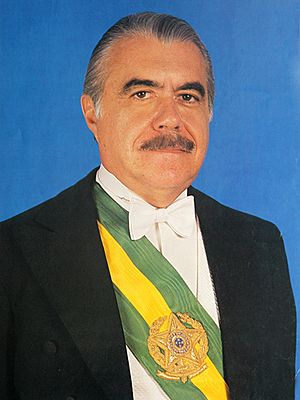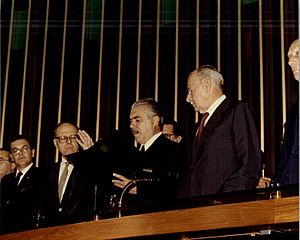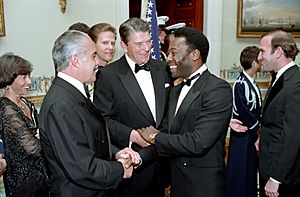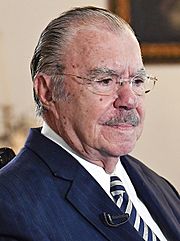José Sarney facts for kids
Quick facts for kids
José Sarney
|
|
|---|---|

Official portrait, 1985
|
|
| 31st President of Brazil | |
| In office 15 March 1985 – 15 March 1990 Acting: 15 March 1985 – 21 April 1985 |
|
| Vice President | None |
| Preceded by | João Figueiredo |
| Succeeded by | Fernando Collor de Mello |
| 20th Vice President of Brazil | |
| In office 15 March 1985 – 21 April 1985 |
|
| President | Tancredo Neves (did not assume) |
| Preceded by | Aureliano Chaves |
| Succeeded by | Itamar Franco |
| President of the Federal Senate | |
| In office 2 February 2009 – 1 February 2013 |
|
| Preceded by | Garibaldi Alves Filho |
| Succeeded by | Renan Calheiros |
| In office 1 February 2003 – 14 February 2005 |
|
| Preceded by | Ramez Tebet |
| Succeeded by | Renan Calheiros |
| In office 2 February 1995 – 4 February 1997 |
|
| Preceded by | Humberto Lucena |
| Succeeded by | Antônio Carlos Magalhães |
| Senator for Amapá | |
| In office 1 February 1991 – 1 February 2015 |
|
| Preceded by | Seat established |
| Succeeded by | Davi Alcolumbre |
| Senator for Maranhão | |
| In office 1 February 1971 – 15 March 1985 |
|
| Preceded by | Vitorino de Brito Freire |
| Succeeded by | Américo de Souza |
| Governor of Maranhão | |
| In office 31 January 1966 – 14 May 1970 |
|
| Vice Governor | Antônio Dino |
| Preceded by | Newton Bello |
| Succeeded by | Antônio Dino |
| Member of the Chamber of Deputies | |
| In office 6 June 1955 – 31 January 1966 |
|
| Constituency | Maranhão |
| Personal details | |
| Born |
José Ribamar Ferreira de Araújo Costa
24 April 1930 Pinheiro, Maranhão, Brazil |
| Political party | PMDB (1985–present) |
| Other political affiliations |
Other parties
|
| Spouse | |
| Children | Roseana, Fernando, José |
| Alma mater | Federal University of Maranhão (UFMA) |
| Signature | |
José Sarney de Araújo Costa (born José Ribamar Ferreira de Araújo Costa on April 24, 1930) is a Brazilian politician, lawyer, and writer. He served as the 31st president of Brazil from 1985 to 1990. Before that, he was the 20th vice president of Brazil for a short time in 1985.
Sarney was a member of the Chamber of Deputies from 1955 to 1966. He was also a Senator from 1971 to 1985. He served as the Governor of Maranhão from 1966 to 1970. During a time when Brazil was led by the military, Sarney was part of the government's main political party. Later, he joined a group that opposed the military government.
He became Vice-President alongside Tancredo Neves. Neves won the election but became very ill and passed away before he could take office. This meant José Sarney became president. During his time as president, Sarney tried to fix Brazil's economic problems, especially high inflation. He also helped create a new, more democratic constitution for Brazil in 1988. After his presidency, Sarney continued his career as a senator. He is the oldest living former Brazilian president.
Contents
Early Life and Education
José Ribamar Ferreira de Araújo Costa was born in Pinheiro, Maranhão. His father, Sarney de Araújo Costa, was a wealthy landowner. José studied at Colégio Marista and Licéu Maranhense. He then went to the Federal University of Maranhão. In 1953, he earned his law degree from the university. After graduating, he started a literary magazine called A Ilha.
In 1965, he officially changed his name to José Sarney de Araújo Costa, which is usually shortened to José Sarney. He was known as "Zé do Sarney," meaning "José, son of Sarney." His father got the name "Sarney" because he was born on land owned by an Englishman named "Sir Ney."
His Political Journey
First Steps in Politics
Sarney began his political career in the 1950s. He first became a replacement deputy and then a federal deputy in 1955. He was part of the National Democratic Union (UDN) party. He supported the military coup in 1964 that removed President João Goulart. After the military took control, Sarney joined the National Renewal Alliance (ARENA), which was the military government's political party. He was elected governor of Maranhão state in 1966 and served until 1971. After that, he was elected to the Brazilian Senate and became the head of the ARENA party.
Becoming Vice President
Even though Sarney supported the military government, he was not always fully accepted by the military leaders. In 1979, ARENA changed its name to the Democratic Social Party (PDS), and Sarney remained its leader. In 1984, many people in Brazil protested, asking for direct elections for president. The PDS party was divided.
Sarney disagreed with some of the party's decisions and left PDS. He helped create the Liberal Front Party. This new party then joined forces with the PMDB. As part of this agreement, Sarney became the running mate for Tancredo Neves, who was the opposition candidate. Neves won the election on January 15, 1985. However, Neves became very sick the night before he was supposed to become president. Sarney took office as Vice President and acting President. Neves passed away on April 21, and Sarney officially became the first civilian president in 21 years.

Leading Brazil as President
When Sarney became president, some people questioned if he should take office. They argued that he was elected Vice President only because Neves was elected President. However, the speaker of the Chamber of Deputies, Ulysses Guimarães, confirmed that Sarney had the right to become acting president.

Sarney and the president of Argentina, Raúl Alfonsín, began working on a plan to create a common market between their two countries in 1985. This agreement later led to the creation of Mercosur in 1991. He also helped change the constitution to remove parts that were left over from the military government.
Sarney faced many challenges as president, including a large foreign debt and very high inflation. He launched economic plans like "Plano Cruzado" to try and stabilize the economy. At first, these plans seemed to work, but inflation later worsened. A new, fully democratic constitution was created in 1988. The next year, Brazil held its first direct presidential elections since 1960. Sarney was not allowed to run for president again right away because his time as acting president counted as a full term.
After Being President
After his presidency, Sarney returned to the Senate, representing Amapá. He served as President of the Senate three times: from 1995 to 1997, 2003 to 2005, and 2009 to 2013. He retired from politics in 2015. At the time, he had one of the longest careers in the Brazilian Congress. He spent almost his entire adult life in elected office, from 1955 until his retirement in 2015.
About His Life
In 1952, Sarney married Marly Macieira. They have three children: José Sarney Filho, Governor Roseana Sarney, and businessman Fernando Sarney.
As a writer, one of his well-known works is the poetry book Os Marimbondos de Fogo ("The Fire Wasps"). In 1980, Sarney was elected to a position in the Brazilian Academy of Letters, which is a very respected group of writers and scholars.
Sarney has had some health issues. In April 2012, he had a heart procedure. In July 2021, he was hospitalized to have fluid removed from his lungs. In July 2023, he was hospitalized after a fall and was diagnosed with a condition affecting blood flow to the brain.
Images for kids
See also
 In Spanish: José Sarney para niños
In Spanish: José Sarney para niños
- List of presidents of Brazil
- History of Brazil (1964-present)
- Presidency of Sarney


